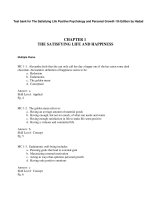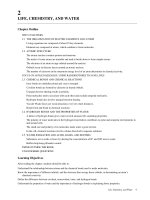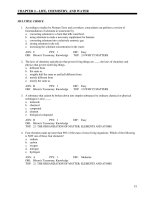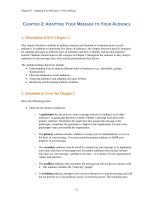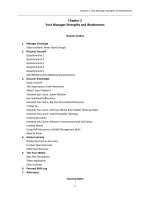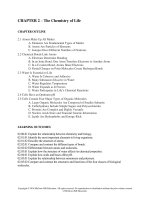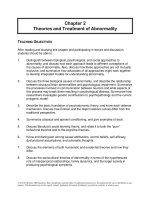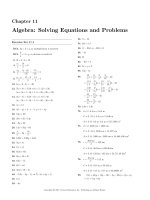Test bank and solution c2 life chemistry and water (2)
Bạn đang xem bản rút gọn của tài liệu. Xem và tải ngay bản đầy đủ của tài liệu tại đây (522.01 KB, 24 trang )
CHAPTER 2—LIFE, CHEMISTRY, AND WATER
MULTIPLE CHOICE
1. According to studies by Norman Terry and coworkers, some plants can perform a version of
bioremediation of selenium in wastewater by
a. converting selenium to a form that kills waterfowl.
b. using selenium to make a necessary supplement for humans.
c. converting selenium into a relatively nontoxic gas.
d. storing selenium in the soil.
e. increasing the selenium concentration in the water.
ANS: C
PTS: 1
OBJ: Bloom's Taxonomy: Knowledge
DIF: Easy
TOP: 2.0 WHY IT MATTERS
2. The laws of chemistry and physics that govern living things are ____ the laws of chemistry and
physics that govern nonliving things.
a. different from
b. the same as
c. roughly half the same as and half different from
d. mostly different from
e. mostly the same as
ANS: B
PTS: 1
OBJ: Bloom's Taxonomy: Knowledge
DIF: Easy
TOP: 2.0 WHY IT MATTERS
3. A substance that cannot be broken down into simpler substances by ordinary chemical or physical
techniques is a(n) ____.
a. molecule
b. chemical
c. compound
d. element
e. biological compound
ANS: D
PTS: 1
DIF: Easy
OBJ: Bloom's Taxonomy: Knowledge
TOP: 2.1 THE ORGANIZATION OF MATTER: ELEMENTS AND ATOMS
4. Four elements make up more than 96% of the mass of most living organisms. Which of the following
is NOT one of those four elements?
a. sodium
b. carbon
c. oxygen
d. nitrogen
e. hydrogen
ANS: A
PTS: 1
DIF: Moderate
OBJ: Bloom's Taxonomy: Knowledge
TOP: 2.1 THE ORGANIZATION OF MATTER: ELEMENTS AND ATOMS
21
5. A trace element is one found in specific organisms in ____ quantities and is ____ for normal biological
functions.
a. moderate; unnecessary
b. moderate; vital
c. small; unnecessary
d. large; unnecessary
e. small; vital
ANS: E
PTS: 1
DIF: Moderate
OBJ: Bloom's Taxonomy: Knowledge
TOP: 2.1 THE ORGANIZATION OF MATTER: ELEMENTS AND ATOMS
6. The smallest unit that retains the chemical and physical properties of an element is a(n) ____.
a. proton
b. compound
c. molecule
d. neutron
e. atom
ANS: E
PTS: 1
DIF: Easy
OBJ: Bloom's Taxonomy: Knowledge
TOP: 2.1 THE ORGANIZATION OF MATTER: ELEMENTS AND ATOMS
7. The substance H2O is considered to be
a. both a molecule and a compound.
b. a compound but not a molecule.
c. neither a molecule nor a compound.
d. a molecule but not a compound.
e. a chemical but not biological molecule.
ANS: A
PTS: 1
DIF: Easy
OBJ: Bloom's Taxonomy: Comprehension
TOP: 2.1 THE ORGANIZATION OF MATTER: ELEMENTS AND ATOMS
8. The substance O2 is considered to be
a. both a molecule and a compound.
b. a compound but not a molecule.
c. neither a molecule nor a compound.
d. a molecule but not a compound.
e. a chemical but not a biological molecule.
ANS: D
PTS: 1
DIF: Moderate
OBJ: Bloom's Taxonomy: Comprehension
TOP: 2.1 THE ORGANIZATION OF MATTER: ELEMENTS AND ATOMS
9. An oxygen atom has ____ surrounding a nucleus composed of ____.
a. neutrons; electrons and protons
b. electrons; protons and neutrons
c. protons and electrons; neutrons
d. protons; neutrons and electrons
e. electrons and neutrons; protons
ANS: B
PTS: 1
OBJ: Bloom's Taxonomy: Knowledge
DIF: Easy
TOP: 2.2 ATOMIC STRUCTURE
22
© 2014 Brooks/Cole, Cengage Learning
Use the figure above for the following question(s).
10. The mass number of the atom depicted in the figure is
a. 5.
b. 7.
c. 8.
d. 15.
e. 22.
ANS: D
PTS: 1
OBJ: Bloom's Taxonomy: Analysis
DIF: Moderate
REF: Figure 2.3
TOP: 2.2 ATOMIC STRUCTURE
11. The atomic number of the atom depicted in the figure is
a. 5.
b. 7.
c. 8.
d. 15.
e. 22.
ANS: B
PTS: 1
OBJ: Bloom's Taxonomy: Analysis
DIF: Moderate
REF: Figure 2.3
TOP: 2.2 ATOMIC STRUCTURE
12. The number of electrons for the atom depicted in the figure is
a. 5.
b. 7.
c. 8.
d. 15.
e. 22.
ANS: B
PTS: 1
OBJ: Bloom's Taxonomy: Analysis
DIF: Easy
REF: Figure 2.3
TOP: 2.2 ATOMIC STRUCTURE
13. The number of neutrons for the atom depicted in the figure is
a. 5.
b. 7.
c. 8.
d. 15.
e. 22.
ANS: C
PTS: 1
OBJ: Bloom's Taxonomy: Analysis
DIF: Easy
REF: Figure 2.3
TOP: 2.2 ATOMIC STRUCTURE
23
14. Which of the following are charged particles?
a. electrons and protons
b. neutrons only
c. protons and neutrons
d. electrons only
e. protons, neutrons, and electrons
ANS: A
PTS: 1
OBJ: Bloom's Taxonomy: Knowledge
DIF: Moderate
TOP: 2.2 ATOMIC STRUCTURE
15. What is the atomic mass number of an atom with 7 electrons, 7 neutrons, and 7 protons?
a. 7 daltons
b. 10 daltons
c. 14 daltons
d. 21 daltons
e. 28 daltons
ANS: C
PTS: 1
DIF: Easy
OBJ: Bloom's Taxonomy: Comprehension
TOP: 2.2 ATOMIC STRUCTURE
16. Isotopes of the same element differ from each other in the number of
a. electrons and protons.
b. neutrons only.
c. protons and neutrons.
d. electrons only.
e. protons, neutrons, and electrons.
ANS: B
PTS: 1
DIF: Moderate
OBJ: Bloom's Taxonomy: Knowledge | Bloom's Taxonomy: Comprehension
TOP: 2.2 ATOMIC STRUCTURE
17. A carbon atom with six protons, seven neutrons, and six electrons has a mass number of
a. 6.
b. 7.
c. 12.
d. 13.
e. 19.
ANS: D
PTS: 1
OBJ: Bloom's Taxonomy: Application
DIF: Moderate
TOP: 2.2 ATOMIC STRUCTURE
18. Which element would the element lithium most likely form an ionic bond with?
a. Aluminum; atomic number = 13
b. Chlorine; atomic number = 17
c. Magnesium; atomic number = 12
d. Nitrogen; atomic number = 7
e. Silicon; atomic number = 14
ANS: B
PTS: 1
OBJ: Bloom's Taxonomy: Analysis
DIF: Moderate
TOP: 2.2 ATOMIC STRUCTURE
24
19.
14
C is heavier than 12C because it has ______.
a. two more electrons than 12C
b. two more neutrons than 12C
c. two more protons than 12C
d. one more proton and one more electron than 12C
e. one more proton and one more neutron than 12C
ANS: B
PTS: 1
OBJ: Bloom's Taxonomy: Analysis
DIF: Moderate
TOP: 2.2 ATOMIC STRUCTURE
20. The isotope 14C undergoes radioactive decay with a neutron splitting into an electron and a proton.
This decay produces an atom of
a. iron.
b. carbon.
c. hydrogen.
d. oxygen.
e. nitrogen.
ANS: E
PTS: 1
OBJ: Bloom's Taxonomy: Knowledge
DIF: Difficult
TOP: 2.2 ATOMIC STRUCTURE
21. An orbital describes the ____ of an electron.
a. exact location
b. exact path
c. most frequent locations
d. charge
e. chemical bonds
ANS: C
PTS: 1
DIF: Moderate
OBJ: Bloom's Taxonomy: Comprehension
TOP: 2.2 ATOMIC STRUCTURE
© 2014 Brooks/Cole, Cengage Learning
Use the figure above for the following question(s).
22. The electrons at the lowest energy level in the neon atom depicted in the figure above are found in
which orbital?
a. 1s
b. 2s
c. 2px
d. 2py
e. 2pz
ANS: A
PTS: 1
DIF: Moderate
OBJ: Bloom's Taxonomy: Comprehension
REF: Figure 2.5
TOP: 2.2 ATOMIC STRUCTURE
25
23. All of the orbitals shown in the neon atom in the figure are completely filled with electrons. How
many electrons does this neon atom have?
a. 5
b. 6
c. 8
d. 10
e. 16
ANS: D
PTS: 1
OBJ: Bloom's Taxonomy: Application
DIF: Moderate
REF: Figure 2.5
TOP: 2.2 ATOMIC STRUCTURE
24. Under the right conditions, an electron can
a. move to a lower energy level.
b. enter an orbital shared by two atoms.
c. move to a higher energy level.
d. move from one atom to another atom.
e. all of these
ANS: E
PTS: 1
OBJ: Bloom's Taxonomy: Knowledge
DIF: Moderate
TOP: 2.2 ATOMIC STRUCTURE
25. Sodium has one valence electron in its third energy level. To reach a stable energy configuration,
sodium will tend to
a. take up an electron from another atom.
b. move its valence electron to the second energy shell.
c. give up an electron to another atom.
d. share its valence electron with another atom.
e. move an electron from the second energy level to the valence shell.
ANS: C
PTS: 1
OBJ: Bloom's Taxonomy: Application
DIF: Moderate
TOP: 2.2 ATOMIC STRUCTURE
26. Which of the following is most likely to share electrons with other atoms in joint orbitals?
a. chlorine (7 valence electrons)
b. calcium (2 valence electrons)
c. argon (8 valence electrons)
d. carbon (4 valence electrons)
e. potassium (1 valence electron)
ANS: D
PTS: 1
OBJ: Bloom's Taxonomy: Synthesis
DIF: Difficult
TOP: 2.2 ATOMIC STRUCTURE
27. Which of the following is likely to be chemically unreactive?
a. chlorine (7 valence electrons)
b. calcium (2 valence electrons)
c. argon (8 valence electrons)
d. carbon (4 valence electrons)
e. potassium (1 valence electron)
ANS: C
PTS: 1
OBJ: Bloom's Taxonomy: Synthesis
DIF: Difficult
TOP: 2.2 ATOMIC STRUCTURE
26
28. Which of the following is most likely to take up an electron from another atom?
a. chlorine (7 valence electrons)
b. calcium (2 valence electrons)
c. neon (8 valence electrons)
d. carbon (4 valence electrons)
e. potassium (1 valence electron)
ANS: A
PTS: 1
OBJ: Bloom's Taxonomy: Synthesis
DIF: Moderate
TOP: 2.2 ATOMIC STRUCTURE
29. Radioactive ____ is commonly used to treat patients with dangerously overactive thyroid glands.
a. carbon
b. radium
c. iodine
d. thallium
e. cobalt
ANS: C
PTS: 1
DIF: Moderate
OBJ: Bloom's Taxonomy: Knowledge
TOP: CHAPTER 2 FOCUS ON RESEARCH: USING RADIOISOTOPES TO SAVE LIVES
30. In radiation therapy, cancer cells are killed by ____.
a. carbon
b. radium
c. iodine
d. thallium
e. nitrogen
ANS: B
PTS: 1
DIF: Moderate
OBJ: Bloom's Taxonomy: Knowledge
TOP: CHAPTER 2 FOCUS ON RESEARCH: USING RADIOISOTOPES TO SAVE LIVES
31. The chemical bonds that form when atoms that have lost electrons are electrically attracted to atoms
that have gained electrons are called ____.
a. polar covalent bonds
b. van der Waals forces
c. ionic bonds
d. hydrogen bonds
e. nonpolar covalent bonds
ANS: C
PTS: 1
DIF: Easy
OBJ: Bloom's Taxonomy: Knowledge
TOP: 2.3 CHEMICAL BONDS AND CHEMICAL REACTIONS
32. The chemical bonds that are formed when atoms share electrons equally are called ____.
a. polar covalent bonds
b. van der Waals forces
c. ionic bonds
d. hydrogen bonds
e. nonpolar covalent bonds
ANS: E
PTS: 1
DIF: Moderate
OBJ: Bloom's Taxonomy: Knowledge | Bloom's Taxonomy: Comprehension
TOP: 2.3 CHEMICAL BONDS AND CHEMICAL REACTIONS
27
33. The chemical bonds that are formed when atoms share electrons unequally are called ____.
a. polar covalent bonds
b. van der Waals forces
c. ionic bonds
d. hydrogen bonds
e. nonpolar covalent bonds
ANS: A
PTS: 1
DIF: Moderate
OBJ: Bloom's Taxonomy: Knowledge | Bloom's Taxonomy: Comprehension
TOP: 2.3 CHEMICAL BONDS AND CHEMICAL REACTIONS
34. The chemical bonds that are formed when atoms with temporary zones of positive charge are attracted
to other atoms with temporary zones of negative charge are called ____.
a. polar covalent bonds
b. van der Waals forces
c. ionic bonds
d. hydrogen bonds
e. nonpolar covalent bonds
ANS: B
PTS: 1
DIF: Difficult
OBJ: Bloom's Taxonomy: Knowledge | Bloom's Taxonomy: Comprehension
TOP: 2.3 CHEMICAL BONDS AND CHEMICAL REACTIONS
35. Chemical bonds that are formed when one atom with a partial positive charge (created from unequal
sharing of electrons) is electrically attracted to another atom with a partial negative charge (also
created from unequal sharing of electrons) are called ____.
a. polar covalent bonds
b. van der Waals forces
c. ionic bonds
d. hydrogen bonds
e. nonpolar covalent bonds
ANS: D
PTS: 1
DIF: Moderate
OBJ: Bloom's Taxonomy: Knowledge | Bloom's Taxonomy: Comprehension
TOP: 2.3 CHEMICAL BONDS AND CHEMICAL REACTIONS
36. Which of the following types of chemical linkages is the weakest?
a. polar covalent bonds
b. van der Waals forces
c. ionic bonds
d. hydrogen bonds
e. nonpolar covalent bonds
ANS: B
PTS: 1
DIF: Difficult
OBJ: Bloom's Taxonomy: Synthesis
TOP: 2.3 CHEMICAL BONDS AND CHEMICAL REACTIONS
37. The attraction between Na+ cations and Cl anions forms ____ that hold together the compound NaCl.
a. polar covalent bonds
b. van der Waals forces
c. ionic bonds
d. hydrogen bonds
e. nonpolar covalent bonds
ANS: C
PTS: 1
DIF: Easy
28
OBJ: Bloom's Taxonomy: Application
TOP: 2.3 CHEMICAL BONDS AND CHEMICAL REACTIONS
38. Geckos are able to cling to vertical walls due to ____.
a. polar covalent bonds
b. van der Waals forces
c. ionic bonds
d. hydrogen bonds
e. nonpolar covalent bonds
ANS: B
PTS: 1
DIF: Difficult
OBJ: Bloom's Taxonomy: Knowledge
TOP: 2.3 CHEMICAL BONDS AND CHEMICAL REACTIONS
39. Molecules such as HH and O=O are held together by ____.
a. polar covalent bonds
b. van der Waals forces
c. ionic bonds
d. hydrogen bonds
e. nonpolar covalent bonds
ANS: E
PTS: 1
DIF: Moderate
OBJ: Bloom's Taxonomy: Synthesis
TOP: 2.3 CHEMICAL BONDS AND CHEMICAL REACTIONS
© 2014 Brooks/Cole, Cengage Learning
40. The molecule shown in the figure above is held together by ____.
a. polar covalent bonds
b. van der Waals forces
c. ionic bonds
d. hydrogen bonds
e. nonpolar covalent bonds
ANS: A
PTS: 1
DIF: Moderate
REF: Figure 2.9
OBJ: Bloom's Taxonomy: Application
TOP: 2.3 CHEMICAL BONDS AND CHEMICAL REACTIONS
29
41. Metallic ions such as Ca2+, Na+, and Fe3+ readily form ____.
a. polar covalent bonds
b. van der Waals forces
c. ionic bonds
d. hydrogen bonds
e. nonpolar covalent bonds
ANS: C
PTS: 1
DIF: Moderate
OBJ: Bloom's Taxonomy: Comprehension
TOP: 2.3 CHEMICAL BONDS AND CHEMICAL REACTIONS
42. The chemical linkages that exert an attractive force over the greatest distance are ____.
a. polar covalent bonds
b. van der Waals forces
c. ionic bonds
d. hydrogen bonds
e. nonpolar covalent bonds
ANS: C
PTS: 1
DIF: Difficult
OBJ: Bloom's Taxonomy: Knowledge
TOP: 2.3 CHEMICAL BONDS AND CHEMICAL REACTIONS
43. In contrast to ionic bonds, covalent bonds ____.
a. hold atoms together
b. have distinct, three-dimensional forms
c. transfer electrons from one atom to another
d. are relatively weak
e. are transient
ANS: B
PTS: 1
DIF: Moderate
OBJ: Bloom's Taxonomy: Synthesis
TOP: 2.3 CHEMICAL BONDS AND CHEMICAL REACTIONS
© 2014 Brooks/Cole, Cengage Learning
44. The dotted line in the figure above indicates ____.
a. a polar covalent bond
b. van der Waals forces
c. an ionic bond
d. a hydrogen bond
e. a nonpolar covalent bond
ANS: D
PTS: 1
DIF: Easy
REF: Figure 2.10
OBJ: Bloom's Taxonomy: Analysis
TOP: 2.3 CHEMICAL BONDS AND CHEMICAL REACTIONS
30
45. In a molecule of methane, CH4, each hydrogen atom shares an orbital with the carbon atom. The total
number of shared electrons in CH4 is ____.
a. 4
b. 2
c. 1
d. 8
e. 5
ANS: D
PTS: 1
DIF: Difficult
OBJ: Bloom's Taxonomy: Analysis
TOP: 2.3 CHEMICAL BONDS AND CHEMICAL REACTIONS
46. A polar covalent bond would be most likely to form between
a. atoms with different electronegativities.
b. cations and anions.
c. atoms with + and charges.
d. atoms with filled valence shells.
e. atoms of the same element.
ANS: A
PTS: 1
DIF: Moderate
OBJ: Bloom's Taxonomy: Evaluation
TOP: 2.3 CHEMICAL BONDS AND CHEMICAL REACTIONS
47. Which of these types of chemical bonds would you not expect to find in biological molecules?
a. covalent bonds
b. van der Waals forces
c. ionic bonds
d. hydrogen bonds
e. all of these types of bonds are found in biological molecules
ANS: E
PTS: 1
DIF: Easy
OBJ: Bloom's Taxonomy: Synthesis
TOP: 2.3 CHEMICAL BONDS AND CHEMICAL REACTIONS
48. In the presence of water, nonpolar associations form between molecules or regions of molecules that
are ____.
a. partially charged
b. hydrophobic and hydrophilic
c. hydrophobic
d. fully charged
e. hydrophilic
ANS: C
PTS: 1
DIF: Easy
OBJ: Bloom's Taxonomy: Knowledge
TOP: 2.3 CHEMICAL BONDS AND CHEMICAL REACTIONS
49. A mixture of vegetable oil and water will separate into layers because oil is ____ and forms ____.
a. hydrophobic; nonpolar associations
b. hydrophilic; nonpolar associations
c. hydrophilic; polar associations
d. hydrophobic; polar associations
e. hydrophobic; ionic associations
ANS: A
PTS: 1
OBJ: Bloom's Taxonomy: Application
DIF: Moderate
31
TOP: 2.3 CHEMICAL BONDS AND CHEMICAL REACTIONS
50. Analyze this chemical reaction:
6 CO2 + 6 H2O C6H12O6 + 6 O2
Which of the following is FALSE?
a. Water is a reactant.
b. C6H12O6 is a product.
c. Molecular oxygen is a product.
d. CO2 is a reactant.
e. Molecular carbon is a reactant.
ANS: E
PTS: 1
DIF: Moderate
OBJ: Bloom's Taxonomy: Analysis
TOP: 2.3 CHEMICAL BONDS AND CHEMICAL REACTIONS
51. The formation and breaking of bonds between atoms requires
a. a chemical reaction.
b. van der Walls forces.
c. partial charges.
d. an empty valence shell.
e. an enzyme.
ANS: A
PTS: 1
DIF: Moderate
OBJ: Bloom's Taxonomy: Knowledge
TOP: 2.3 CHEMICAL BONDS AND CHEMICAL REACTIONS
52. What do cohesion, surface tension, and specific heat have in common concerning the properties of
water?
a. All are produced by covalent bonding.
b. All are properties related to hydrogen bonding.
c. All have to do with nonpolar covalent bonds.
d. All increase when temperature increases.
e. All are produced by covalent bonding and all increase when temperature increases.
ANS: B
PTS: 1
DIF: Easy
OBJ: Bloom's Taxonomy: Knowledge
TOP: 2.4 HYDROGEN BONDS AND THE PROPERTIES OF WATER
53. A molecule of water in the middle of a chunk of ice will usually have ____ hydrogen bonds with other
water molecules.
a. 3
b. 3.4
c. 6
d. 4
e. 2
ANS: D
PTS: 1
DIF: Moderate
OBJ: Bloom's Taxonomy: Application
TOP: 2.4 HYDROGEN BONDS AND THE PROPERTIES OF WATER
32
54. Which of the following would have the most difficulty entering a water lattice?
a. table salt (NaCl)
b. a nonpolar molecule
c. a sodium ion
d. a proton (H+)
e. an electron
ANS: B
PTS: 1
DIF: Moderate
OBJ: Bloom's Taxonomy: Application
TOP: 2.4 HYDROGEN BONDS AND THE PROPERTIES OF WATER
55. Ice floats in liquid water because
a. ice forms hydrogen bonds with the surface of liquid water.
b. ice forms hydrogen bonds but liquid water does not.
c. the hydrogen bonds of liquid water are fixed in place.
d. liquid water forms hydrogen bonds but ice does not.
e. the distance between water molecules is maximized due to the hydrogen bonds which are
fixed in place.
ANS: E
PTS: 1
DIF: Difficult
OBJ: Bloom's Taxonomy: Application
TOP: 2.4 HYDROGEN BONDS AND THE PROPERTIES OF WATER
56. Biological membranes are held together mainly by
a. hydrogen bonds between lipid molecules.
b. hydration layers over lipid molecules.
c. exclusion of the nonpolar regions of lipids by water.
d. hydrogen bonds between water molecules.
e. surface tension at the interface between layers of water molecules.
ANS: C
PTS: 1
DIF: Moderate
OBJ: Bloom's Taxonomy: Knowledge
TOP: 2.4 HYDROGEN BONDS AND THE PROPERTIES OF WATER
57. A ____ is formed when a ____ is dissolved in a ____.
a. solution; solute; solvent
b. solute; solvent; solution
c. solution; solvent; solute
d. solvent; solution; solute
e. solvent; solute; solution
ANS: A
PTS: 1
DIF: Moderate
OBJ: Bloom's Taxonomy: Knowledge
TOP: 2.4 HYDROGEN BONDS AND THE PROPERTIES OF WATER
58. When sugar dissolves in water, water is acting as a ____ and the sugar molecules are acting as ____.
a. solution; solvents
b. solute; solutions
c. solvent; solutes
d. solute; solvents
e. solvent; solutions
ANS: C
PTS: 1
DIF: Moderate
OBJ: Bloom's Taxonomy: Application
TOP: 2.4 HYDROGEN BONDS AND THE PROPERTIES OF WATER
33
© 2014 Brooks/Cole, Cengage Learning
59. When salt dissolves in water as illustrated in the figure above, the water molecules form ____ around
the Na+ and Cl ions.
a. covalent bonds
b. hydration layers
c. nonpolar interactions
d. membranes
e. ionic bonds
ANS: B
PTS: 1
DIF: Easy
REF: Figure 2.15
OBJ: Bloom's Taxonomy: Comprehension
TOP: 2.4 HYDROGEN BONDS AND THE PROPERTIES OF WATER
34
60. Water has a molecular weight of 18 g per mole, and glucose has a molecular weight of 180 g per mole.
Which of the following would have an approximately equal number of water and glucose molecules?
a. 1 g of water and 180 g of glucose
b. 90 g of water and 9 g of glucose
c. 180 g of water and 1 g of glucose
d. 9 g of water and 90 g of glucose
e. 90 g of water and 90 g of glucose
ANS: D
PTS: 1
DIF: Difficult
OBJ: Bloom's Taxonomy: Application
TOP: 2.4 HYDROGEN BONDS AND THE PROPERTIES OF WATER
61. Water has an unusually high boiling point for its molecular weight because water molecules
a. are very dense.
b. get much heavier as they are heated.
c. are held to each other by hydrogen bonds.
d. are held together by covalent bonds.
e. form hydration layers.
ANS: C
PTS: 1
DIF: Moderate
OBJ: Bloom's Taxonomy: Comprehension
TOP: 2.4 HYDROGEN BONDS AND THE PROPERTIES OF WATER
62. The hydrogen-bond lattice causes water to have an unusually ____ specific heat and an unusually ____
heat of vaporization for its molecular weight.
a. high; high
b. low; high
c. high; low
d. low; low
ANS: A
PTS: 1
DIF: Easy
OBJ: Bloom's Taxonomy: Comprehension
TOP: 2.4 HYDROGEN BONDS AND THE PROPERTIES OF WATER
63. Water is useful for cooling organisms mainly due to its
a. hydration layers.
b. specific heat.
c. low calories.
d. surface tension.
e. heat of vaporization.
ANS: E
PTS: 1
DIF: Moderate
OBJ: Bloom's Taxonomy: Knowledge
TOP: 2.4 HYDROGEN BONDS AND THE PROPERTIES OF WATER
64. Water has an important stabilizing effect on temperature in living organisms and their environments
because as water absorbs heat, much of the energy is used to ____ instead of raising the temperature.
a. create hydrogen bonds
b. create covalent bonds
c. break surface tension
d. break hydrogen bonds
e. create hydration layers
ANS: D
PTS: 1
DIF: Moderate
OBJ: Bloom's Taxonomy: Comprehension
35
TOP: 2.4 HYDROGEN BONDS AND THE PROPERTIES OF WATER
© 2014 Brooks/Cole, Cengage Learning
65. The water strider shown in the figure above is able to stand on water because of the ____ of water.
a. covalent bonds
b. surface tension
c. van der Waals forces
d. density
e. hydration layer
ANS: B
PTS: 1
DIF: Easy
REF: Figure 2.13
OBJ: Bloom's Taxonomy: Knowledge
TOP: 2.4 HYDROGEN BONDS AND THE PROPERTIES OF WATER
66. When added to water, a base will act as a(n) ____ and cause the pH of the solution to ____.
a. proton acceptor; rise
b. proton donor; rise
c. proton acceptor; fall
d. proton donor; fall
e. acid; fall
ANS: A
PTS: 1
DIF: Easy
OBJ: Bloom's Taxonomy: Comprehension
TOP: 2.5 WATER IONIZATION AND ACIDS, BASES, AND BUFFERS
67. When added to water at neutral pH (7.0), an acid will
a. act as a proton donor, raising the pH of the solution.
b. act as a proton acceptor, raising the pH of the solution.
c. act as a proton donor, lowering the pH of the solution.
d. act as a proton acceptor, lowering the pH of the solution.
e. do nothing since the aqueous solution is neutral.
ANS: C
PTS: 1
DIF: Moderate
OBJ: Bloom's Taxonomy: Application
TOP: 2.5 WATER IONIZATION AND ACIDS, BASES, AND BUFFERS
68. A pH of 6 is ____ times more ____ than a pH of 2.
a. 3; acidic
b. 4; acidic
c. 3; basic
d. 10,000; basic
e. 40; basic
ANS: D
PTS: 1
OBJ: Bloom's Taxonomy: Application
DIF: Moderate
36
TOP: 2.5 WATER IONIZATION AND ACIDS, BASES, AND BUFFERS
69. For pure water, which has a pH of 7.0, which of the following is true?
a. [H+] < [OH]
b. [H+] = [OH]
c. [H+] = 0
d. [OH] = 0
e. [H+] > [OH]
ANS: B
PTS: 1
DIF: Moderate
OBJ: Bloom's Taxonomy: Knowledge | Bloom's Taxonomy: Application
TOP: 2.5 WATER IONIZATION AND ACIDS, BASES, AND BUFFERS
70. For acid rainwater, which has a pH as low as 3.0, which of the following is true?
a. [H+] < [OH]
b. [H+] = [OH]
c. [H+] = 0
d. [OH] = 0
e. [H+] > [OH]
ANS: E
PTS: 1
DIF: Moderate
OBJ: Bloom's Taxonomy: Knowledge | Bloom's Taxonomy: Application
TOP: 2.5 WATER IONIZATION AND ACIDS, BASES, AND BUFFERS
71. Solution A has a pH of 6 and solution B has a pH of 8. Which of the following is true regarding the
concentration of hydrogen ions in each solution?
a. A has 100 times greater H+ concentration than B.
b. B has 100 times greater H+ concentration than A.
c. A has 7/9 of the H+ concentration of B.
d. A has 9/7 of the H+ concentration of B.
e. A has 1,000 times greater H+ concentration than B.
ANS: A
PTS: 1
DIF: Moderate
OBJ: Bloom's Taxonomy: Analysis
TOP: 2.5 WATER IONIZATION AND ACIDS, BASES AND BUFFERS
72. In water, NaOH almost completely separates into Na+ and OH- ions. Thus, NaOH is _____.
a. a strong acid
b. a strong base
c. a weak acid
d. a weak base
e. neutral
ANS: B
PTS: 1
DIF: Moderate
OBJ: Bloom's Taxonomy: Comprehension
TOP: 2.5 WATER IONIZATION AND ACIDS, BASES AND BUFFERS
73. Seawater typically is
a. highly basic.
b. neutral.
c. somewhat basic.
d. somewhat acidic.
e. highly basic.
ANS: C
PTS: 1
DIF: Difficult
37
OBJ: Bloom's Taxonomy: Knowledge | Bloom's Taxonomy: Analysis
TOP: 2.5 WATER IONIZATION AND ACIDS, BASES, AND BUFFERS
74. Without ____, living organisms would often experience major changes in pH in their cells.
a. buffers
b. acids
c. surface tension
d. nonpolar bonds
e. bases
ANS: A
PTS: 1
DIF: Easy
OBJ: Bloom's Taxonomy: Knowledge
TOP: 2.5 WATER IONIZATION AND ACIDS, BASES, AND BUFFERS
75. Most pH buffers are
a. strong acids.
b. weak acids or weak bases.
c. weak acids.
d. strong bases.
e. strong acids or strong bases.
ANS: B
PTS: 1
DIF: Moderate
OBJ: Bloom's Taxonomy: Knowledge
TOP: 2.5 WATER IONIZATION AND ACIDS, BASES, AND BUFFERS
76. A research group led by Li Li has found a(n) ____ that potentially can be used in uranium
bioremediation.
a. amoeba
b. plant
c. alga
d. bacterium
e. fungus
ANS: D
PTS: 1
OBJ: Bloom's Taxonomy: Knowledge
DIF: Moderate
TOP: CHAPTER 2 UNANSWERED QUESTIONS
77. The most common isotope of carbon has an atomic number of 6 and a mass number of 12, while the
most common isotope of oxygen has an atomic number of 8 and a mass number of 16. A molecule of
CO2 made up of these common isotopes has a molecular weight of ____.
a. 28
b. 44
c. 56
d. 14
e. 22
ANS: B
PTS: 1
DIF: Difficult
REF: Section 2.2 | Section 2.3 | Section 2.4
OBJ: Bloom's Taxonomy: Synthesis
MSC: Integrative Multiple Choice
38
© 2014 Brooks/Cole, Cengage Learning
78. The water lattice illustrated in the figure above forms as a result of ____ between water molecules.
a. covalent bonds
b. hydrogen bonds
c. nonpolar interactions
d. ionic bonds
e. van der Walls forces
ANS:
REF:
OBJ:
MSC:
B
PTS: 1
DIF: Easy
Figure 2.12 | Section 2.3 | Section 2.4
Bloom's Taxonomy: Application | Bloom's Taxonomy: Synthesis
Integrative Multiple Choice
MATCHING
Match each of the following terms with its correct definition.
a. Anything that occupies space and has mass
b. A pure substance that cannot be broken down into simpler substances by ordinary
chemical or physical techniques
c. An atom with the same number of protons as another atom but a different number of
neutrons
d. The locations around an atomic nucleus where an electron occurs most frequently
e. A molecule whose component atoms are different from each other
79.
80.
81.
82.
83.
element
compound
matter
orbital
isotope
79. ANS:
OBJ:
80. ANS:
OBJ:
81. ANS:
OBJ:
82. ANS:
OBJ:
B
PTS: 1
Bloom's Taxonomy: Knowledge
E
PTS: 1
Bloom's Taxonomy: Knowledge
A
PTS: 1
Bloom's Taxonomy: Knowledge
D
PTS: 1
Bloom's Taxonomy: Knowledge
DIF: Moderate
REF: Section 2.1 | Section 2.2
DIF: Moderate
REF: Section 2.1 | Section 2.2
DIF: Moderate
REF: Section 2.1 | Section 2.2
DIF: Moderate
REF: Section 2.1 | Section 2.2
39
83. ANS: C
PTS: 1
OBJ: Bloom's Taxonomy: Knowledge
DIF: Moderate
REF: Section 2.1 | Section 2.2
For each of the following situations, choose the correct type of chemical bond.
a. ionic bond(s)
b. nonpolar covalent bond(s)
c. polar covalent bond(s)
d. hydrogen bond(s)
e. van der Waals forces
84. Occurs when electrons are shared equally between two atoms
85. Used by geckos for clinging to and climbing up smooth vertical surfaces
86. Formed by the attraction between partial positive and partial negative charges created by unequal
electron sharing
87. Occurs in sodium chloride (NaCl)
88. The weakest of the chemical linkages listed
89. Occurs in a water molecule (H2O)
90. Characteristic of molecules that contain atoms of only one kind
91. Forms when atoms gain or lose valence electrons completely
92. Attraction that arises when the constant movement of electrons, by chance, produces temporary zones
of partial positive and partial negative charges
93. Occurs when electrons are shared unequally between two atoms
94. Creates a region that is hydrophobic
95. Occurs between water molecules
96. Occurs in molecular oxygen (O2)
84. ANS:
OBJ:
MSC:
85. ANS:
OBJ:
MSC:
86. ANS:
OBJ:
MSC:
87. ANS:
OBJ:
MSC:
88. ANS:
OBJ:
MSC:
89. ANS:
OBJ:
MSC:
90. ANS:
OBJ:
MSC:
91. ANS:
OBJ:
MSC:
92. ANS:
B
PTS: 1
DIF: Moderate
REF: Section 2.3
Bloom's Taxonomy: Knowledge | Bloom's Taxonomy: Application
Choice
E
PTS: 1
DIF: Moderate
REF: Section 2.3
Bloom's Taxonomy: Knowledge | Bloom's Taxonomy: Application
Choice
D
PTS: 1
DIF: Moderate
REF: Section 2.3
Bloom's Taxonomy: Knowledge | Bloom's Taxonomy: Application
Choice
A
PTS: 1
DIF: Moderate
REF: Section 2.3
Bloom's Taxonomy: Knowledge | Bloom's Taxonomy: Application
Choice
E
PTS: 1
DIF: Moderate
REF: Section 2.3
Bloom's Taxonomy: Knowledge | Bloom's Taxonomy: Application
Choice
C
PTS: 1
DIF: Moderate
REF: Section 2.3
Bloom's Taxonomy: Knowledge | Bloom's Taxonomy: Application
Choice
B
PTS: 1
DIF: Moderate
REF: Section 2.3
Bloom's Taxonomy: Knowledge | Bloom's Taxonomy: Application
Choice
A
PTS: 1
DIF: Moderate
REF: Section 2.3
Bloom's Taxonomy: Knowledge | Bloom's Taxonomy: Application
Choice
E
PTS: 1
DIF: Moderate
REF: Section 2.3
40
93.
94.
95.
96.
OBJ:
MSC:
ANS:
OBJ:
MSC:
ANS:
OBJ:
MSC:
ANS:
OBJ:
MSC:
ANS:
OBJ:
MSC:
Bloom's Taxonomy: Knowledge | Bloom's Taxonomy: Application
Choice
C
PTS: 1
DIF: Moderate
REF: Section 2.3
Bloom's Taxonomy: Knowledge | Bloom's Taxonomy: Application
Choice
B
PTS: 1
DIF: Moderate
REF: Section 2.3
Bloom's Taxonomy: Knowledge | Bloom's Taxonomy: Application
Choice
D
PTS: 1
DIF: Moderate
REF: Section 2.3
Bloom's Taxonomy: Knowledge | Bloom's Taxonomy: Application
Choice
B
PTS: 1
DIF: Moderate
REF: Section 2.3
Bloom's Taxonomy: Knowledge | Bloom's Taxonomy: Application
Choice
SHORT ANSWER
97. Why is iodine considered a trace element that is vital for biological function in humans?
ANS:
Iodine is 0.0004% of a human’s weight, compared to elements that occur at quantities greater than
0.01%. Iodine is required for proper thyroid gland function. Lack of iodine affects metabolism and
growth. In the short-term iodine deficiency results in lethargy, apathy and sensitivity to cold
temperatures, in the long-term, iodine deficiency causes a goiter.
PTS: 1
DIF: Easy
OBJ: Bloom's Taxonomy: Knowledge
REF: Section 2.1
98. Place a large amount of hydrogen gas and oxygen gas in the presence of a fire and you will get an
explosion. In light of this, explain how it is possible that water, which is composed of hydrogen and
oxygen, is often used to put out fires.
ANS:
Water is a compound, and compounds typically have chemical and physical properties that are distinct
from the atoms that make them up. So, water had different properties than the hydrogen and oxygen
that it is made of and thus behaves differently from them in the presence of fire.
PTS: 1
DIF: Moderate
OBJ: Bloom's Taxonomy: Analysis
REF: Section 2.1
99. How could you use 14C to deduce the overall reaction of photosynthesis?
ANS:
The radioactive isotope of carbon could be traced from labeled carbon dioxide. The carbon on the
reactant, carbon dioxide, would ultimately be found in one of the products, a sugar. The reaction could
be stopped at various points and reveal intermediate reactions.
PTS: 1
DIF: Difficult
REF: Section 2.2 | Section 2.4
OBJ: Bloom's Taxonomy: Application | Bloom's Taxonomy: Comprehension
41
100. If van der Waals forces are weak, how can geckos utilize these forces to cling to and walk up vertical
smooth surfaces?
ANS:
The toes of geckos are covered by millions of hairs (setae). At the tip of each setae are hundreds of
thousands of pads, where each pad forms a weak interaction with a smooth surface due to van der
Waal forces. Collectively, these forces form strong attractive forces.
PTS: 1
DIF: Easy
REF: Section 2.3
OBJ: Bloom's Taxonomy: Knowledge | Bloom's Taxonomy: Comprehension
101. Describe the difference between cohesion and adhesion, and how they combine to allow water to move
upward in plants.
ANS:
Cohesion is the resistance of a molecule to separate, where adhesion is the ability of molecules to stick
to surfaces. Cohesion in water is the resistance to separate due to the hydrogen-bond lattice. Adhesion
in water is the ability of hydrogen bonds to form with charged and polar groups associated with
surfaces. A water column in a plant is a result of cohesion – water molecules being held together – and
maintained by water adhering to the walls of the water conducting tissue (xylem).
PTS: 1
DIF: Moderate
REF: Section 2.4
OBJ: Bloom's Taxonomy: Comprehension | Bloom's Taxonomy: Synthesis
MODIFIED TRUE/FALSE
If the statement is true, answer "T". If the statement is false, answer "F" and make it correct by
changing the underlined word(s) and writing the correct word(s) in the answer blank(s).
102. An understanding of the relationship between the structure of elemental substances and their behavior
is the first step in learning biology.
ANS: F, chemical
PTS: 1
DIF: Moderate
OBJ: Bloom's Taxonomy: Knowledge
REF: Section 2.1
103. Carbon dioxide is an element.
ANS: F, a compound
PTS: 1
DIF: Moderate
OBJ: Bloom's Taxonomy: Knowledge
REF: Section 2.1
104. Atoms with atomic numbers between lithium and neon have two energy levels.
ANS: T
REF: Section 2.2
PTS: 1
OBJ: Bloom's Taxonomy: Knowledge
DIF:
Moderate
42
105. Radioactivity can destroy cancerous tissue but not healthy tissue.
ANS: F, also
PTS: 1
DIF: Moderate
REF: Focus on Research: Using Radioisotopes to Save Lives
OBJ: Bloom's Taxonomy: Knowledge | Bloom's Taxonomy: Comprehension
106. Polar molecules that associate readily with carbon dioxide are hydrophilic.
ANS: F, water
PTS: 1
DIF: Easy
OBJ: Bloom's Taxonomy: Knowledge
REF: Section 2.3
107. A typical candy bar has approximately 250,000 Calories.
ANS: F, calories
PTS: 1
DIF: Moderate
OBJ: Bloom's Taxonomy: Knowledge
REF: Section 2.4
108. Vinegar is a good cleaning solution because it is a weak acid, while ammonia is a good cleaner
because it is a weak base.
ANS: T
REF: Section 2.5
PTS: 1
OBJ: Bloom's Taxonomy: Knowledge
DIF:
Moderate
109. The metabolism of some bacteria transforms uranium from its soluble form to an insoluble form.
ANS: T
REF: Unanswered Questions
PTS: 1
DIF: Moderate
OBJ: Bloom's Taxonomy: Knowledge
ESSAY
110. Oxygen generally forms two covalent bonds, while carbon generally forms four covalent bonds. In
contrast, helium is inert (generally does not form any bonds). Explain the reason for the differences in
chemical behavior between these three elements.
ANS:
The number of valence electrons in the outermost energy level, or valence shell, determines chemical
reactivity. Atoms of an element with a filled valence shell, such as helium, are nonreactive. In contrast,
atoms with an unfilled valence shell are reactive; they will tend to gain, lose, or share electrons so that
they wind up with a filled valence shell. Oxygen needs two electrons to fill its valence shell, so it tends
to form two covalent bonds. Carbon needs four electrons to fill its valence shell so it tends to form four
covalent bonds.
PTS: 1
DIF: Moderate
REF: Section 2.2
OBJ: Bloom's Taxonomy: Application | Bloom's Taxonomy: Synthesis
43
111. Describe how the interaction of water with dual polarity lipid molecules establishes biological
membranes.
ANS:
The hydrogen bonding between water molecules forms a lattice that resists invasion by nonpolar
molecules. However, polar molecules can interact with the hydrogen-bond lattice. Lipid molecules
with both polar and nonpolar regions can align in a bilayer, with the lipid molecules oriented so that
their polar regions are on either side of the bilayer and their nonpolar regions are buried in the middle
of the bilayer. In this arrangement only the polar ends are exposed to the water. This creates a
membrane of lipid molecules that separates the watery solution on one side of the bilayer from the
watery solution on the other side of the bilayer.
PTS: 1
DIF: Moderate
OBJ: Bloom's Taxonomy: Synthesis
REF: Section 2.4
44

